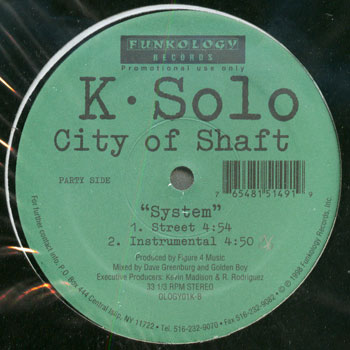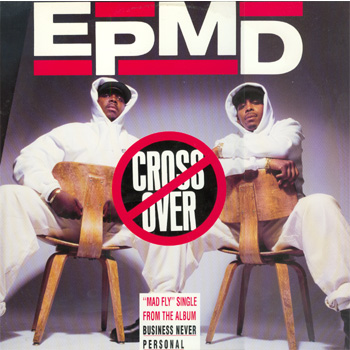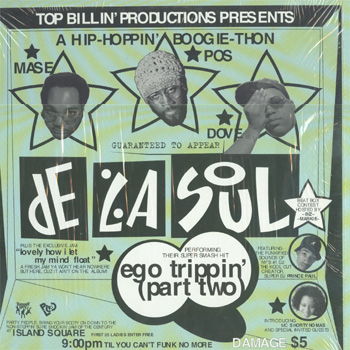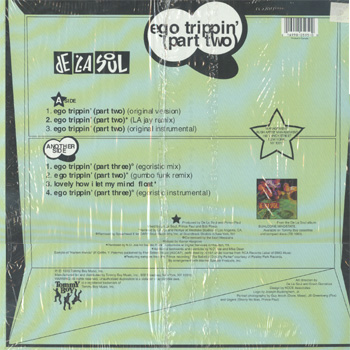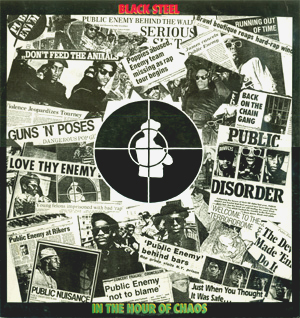
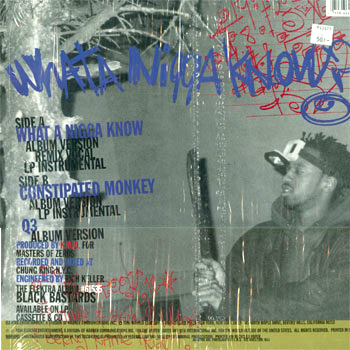 KMD & Grim Reaper : What A Nigga Know Remix (Elektra, 1994)
KMD & Grim Reaper : What A Nigga Know Remix (Elektra, 1994)The main focus of this blog is not really remixes, but sometimes you may wonder what's the definition of a remix after all ? Literally a remix is supposed to be a different mix of a song,
you turn the bass up, add some percussion and flip the sample differently. Back in the 80s it was closer to arrangement than composition. Then in the early 90's most hip hop remixers started to do beats out of scratch and just blended a cappellas over it. Then Sean Combs came and "invented" the remix, very usefull when you know your rapper won’t be around next year but you have a dope beat and you want to extended the longevity of the song. You just cast
a bunch of free lance MCs to spit rhymes over the original music. But nowadays you hear remixes with different beat AND different lyrics, so I guess a remix can be anything.
This song is listed as the remix to
What A Nigga Know. The beat has nothing in common with the original, the lyrics are totally different, and MF Grimm appears as an uncredited guest on the song. I used to think that it was a typo, or a type of mistake on the 12” artwork, but it seems that this was not a song per se, but really another version of What A Nigga Know. OK, they don’t even say the words What A Nigga Know in the remix, but whatever... That particular song was one of the very first time we heard The Grim Reaper. If memory serves me correct this 12” dropped in april 1994, just a few weeks after Kurious’ album where Grim made his debut on “Baby Bust It”. The remix pitches a strong line from Gil Scott-Heron’s ballad “Pieces Of A Man” as a hook, not a surprise since the
Black Bastard album was strongly influenced by spoken word.
I remember buying the record when it came out, and loved it so much that I used the instrumental to open my radio show for a whole year in 94/95, and from 95 I used a beat I made sampling the Constipated Monkey bassline. I was really expecting the album and I was really sad when someone told me
they got dropped from Elektra over some artwork argument. I guess artwork was a very sensitive subject for WEA back then because they used the
same reason to
refuse to distribute more than
a few records that same year.
I found a bootleg copy of the album during the summer of 1994 in London, and of course the so-called “remix” was not on it. However it was included as a bonus on the original official pressing of the album, released years later on Subverse. Bobbito also had re-release the 12” on Fondle’em in 1998.
KMD & Grim Reaper : What A Nigga Know Remix (Elektra, 1994)
Le thème de ce blog n’est pas vraiment les remixes, pourtant on doit parfois se poser la question : quelle est la différence entre un remix et un morceau original ? Etymologiquement un remix est un mix alternatif,
on remonte un peu la basse, on ajoute des percu, et éventuellement on triture le sample... Dans les années 80 les remixes tenaient plus de l’arrangement que de la composition. Ensuite au début des années 90 les remixeurs hip hop ont commencé à refaire totalement des beats qui n’avaient rien à voir, et à coller les a capella dessus. Et puis Puff Daddy est arrivé et il a inventé le remix… Très pratique quand on a un rappeur non charismatique mais un instru mortel et qu’on veut prolonger un peu la durée de vie du morceau. Il suffit de payer
quelques mercenaires de la rime pour leur faire enregistrer un couplet sur le beat existant. De nos jours on a franchit la dernière étape puisqu’on entend des remixes où les beats ET les rappeurs différents, à croire que n’importe quel titre est un remix à partir du moment où on a décidé de l’appeler remix.
Le morceau que voici est censé être le remix de
What A Nigga Know. Le beat n’a rien à voir avec celui de la version originale, les paroles du morceau sont différentes, et il y a un invité non crédité, le Grim Reaper connu maintenant sous le nom de MF Grimm. A l ‘époque je pensais qu’il y avait eu une erreur sur la pochette est que le titre de ce morceau avait été oublié, mais il semble que c’était vraiment un remix de What A Nigga Know, même si ni Zev Lov X, ni Grim ne prononcent les mots What A Nigga Know dans leurs textes… C’était une des toutes premières fois qu’on entendait Grim Reaper, il avait seulement posé un couplet sur l’album de Kurious sorti quelques semaines auparavant.
Je me souviens avoir tellement aimé le maxi à l’époque au point que je l’avais utilisé deux ans de suite pour le générique de mon émission Amis De La Poesie Bonsoir, en 94/95 j’avais pris l’instru de What A Nigga Know, et l’année d’après j’avais composé un générique qui samplait la basse de Constipated Monkey. J’attendais l’album avec impatience, et j’étais réélement triste quand j’ai appris que
le groupe avait perdu son contrat avec Elektra à cause de leur pochette. Il faut croire que les pochettes de disques de rap étaient un sujet sensible pour WEA en ce temps là, puisqu’il avaient utilisé
la même excuse pour
se séparer de
plusieurs groupes la même année...
A l’été 1994 j’ai trouvé une version bootleg de l’album à Londres qui ne contenait pas alors le soit disant remix. Il n’était pas non plus sur la version sortie en autoproduction par MF Doom en 2000, mais a été ajouté en bonus sur le pressage SubVerse en 2001. Le remix est également trouvable sur la réédition du maxi sorti chez Fondle’em en 19998.







